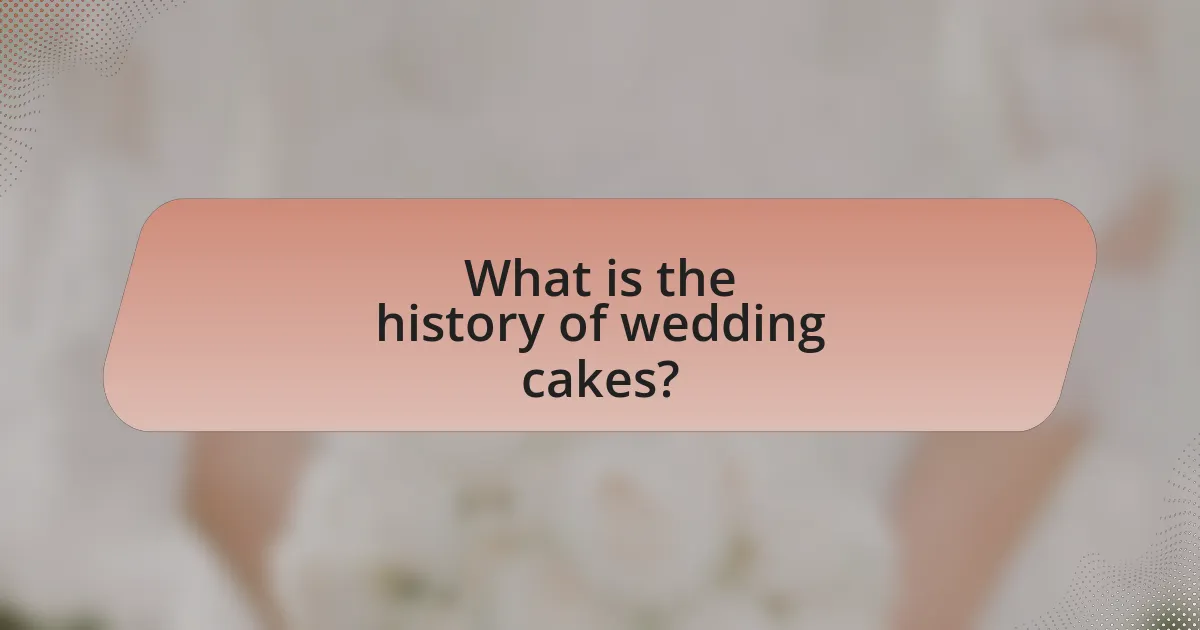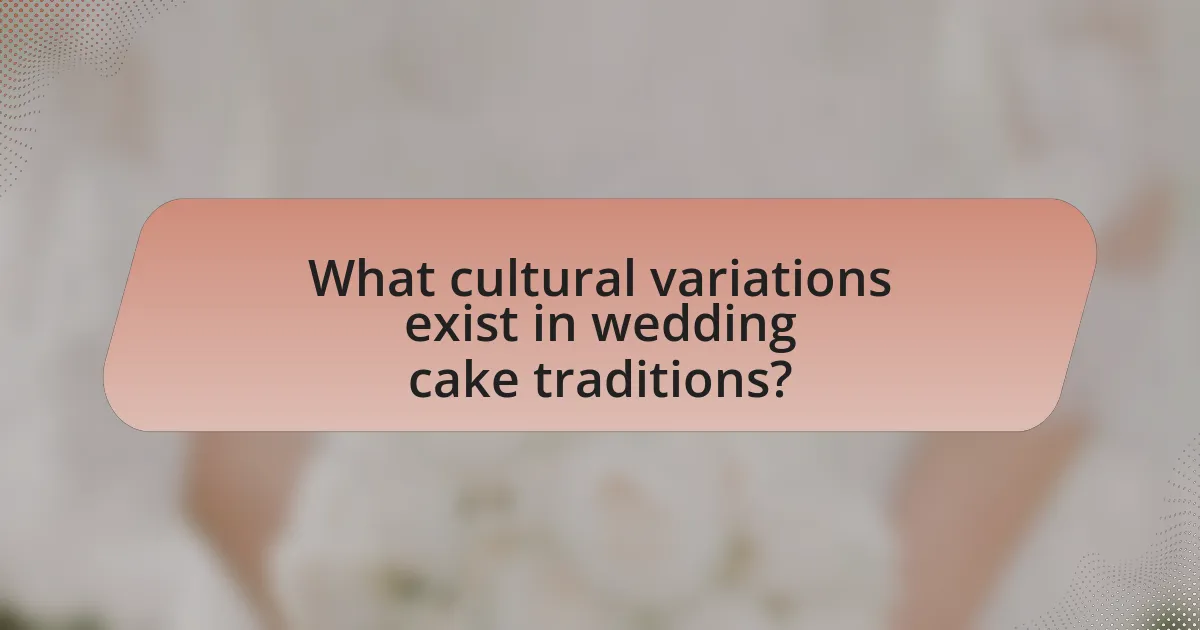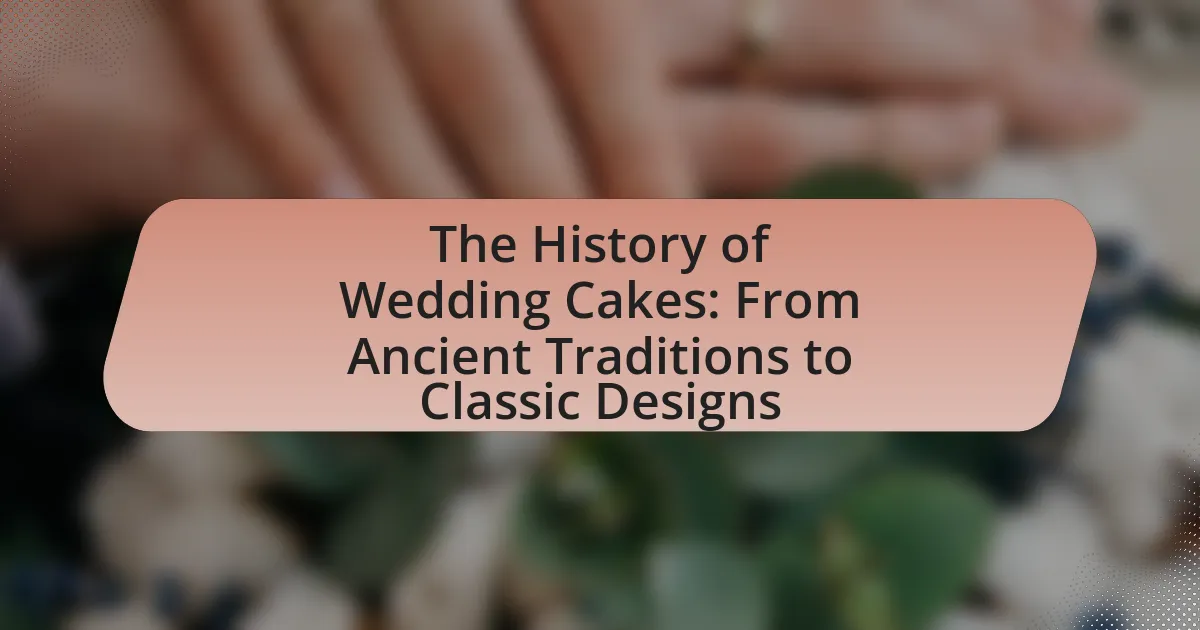The article explores the history of wedding cakes, tracing their origins from ancient Rome, where simple barley cakes symbolized fertility, to the elaborate multi-tiered designs popularized in the Victorian era. It examines the evolution of wedding cake traditions across various cultures, highlighting key milestones such as the introduction of sugar and the rise of personalized designs in modern weddings. Additionally, the article discusses common misconceptions about wedding cakes, the significance of flavors and fillings, and contemporary trends that reflect individual styles and cultural variations in wedding celebrations.

What is the history of wedding cakes?
The history of wedding cakes dates back to ancient Rome, where a simple barley cake was broken over the bride’s head to symbolize fertility and good fortune. Over time, this practice evolved, and by the Middle Ages, cakes made of wheat flour and honey became popular in England, often featuring spices and dried fruits. The modern tiered wedding cake emerged in the 19th century, influenced by advancements in baking and sugarcraft, allowing for elaborate designs and the use of fondant. The tradition of a white wedding cake, symbolizing purity, became prominent in the Victorian era, particularly after Queen Victoria’s wedding to Prince Albert in 1840, which popularized the white icing style.
How did wedding cakes originate in ancient cultures?
Wedding cakes originated in ancient cultures as a symbol of fertility and prosperity. In ancient Rome, guests would bring wheat or barley cakes to weddings, which were then crumbled over the bride’s head to bestow good fortune. Similarly, in ancient Greece, cakes made of honey and sesame seeds were offered to the goddess Hera during weddings, signifying blessings for the couple. These practices laid the groundwork for the modern wedding cake tradition, evolving over time into the multi-tiered confections we see today.
What were the earliest forms of wedding cakes in ancient Rome?
The earliest forms of wedding cakes in ancient Rome were simple barley cakes or bread, which were broken over the bride’s head during the wedding ceremony to symbolize fertility and good fortune. These cakes were not sweetened or elaborately decorated, reflecting the practical and symbolic nature of Roman wedding customs. The tradition of breaking the cake over the bride’s head was believed to bring blessings to the couple, and the remnants were often shared among the guests to spread good luck.
How did the Greeks influence wedding cake traditions?
The Greeks significantly influenced wedding cake traditions by introducing the practice of using cakes in wedding ceremonies, particularly through the use of honey cakes. In ancient Greece, honey cakes were offered to the gods during weddings, symbolizing fertility and prosperity. This tradition evolved over time, leading to the modern concept of wedding cakes, where layers and elaborate designs became prominent, reflecting the Greeks’ emphasis on celebration and ritual in marriage. The incorporation of honey and other ingredients in these cakes laid the groundwork for the rich flavors and decorative styles seen in contemporary wedding cakes.
What role did wedding cakes play in medieval Europe?
Wedding cakes in medieval Europe symbolized prosperity and fertility, serving as a central element in wedding celebrations. During this period, cakes were often made from wheat, which represented abundance, and were typically stacked or layered to signify the couple’s future together. The tradition of breaking the cake over the bride’s head was believed to bring good fortune and fertility, reinforcing the cake’s role as a symbol of blessings for the newlyweds. Historical records indicate that these cakes evolved from simple bread to more elaborate confections, reflecting the couple’s social status and the community’s wealth.
How were wedding cakes used in royal ceremonies?
Wedding cakes were integral to royal ceremonies, symbolizing prosperity and unity. Historically, these cakes were often elaborately designed and served as a centerpiece during royal weddings, reflecting the wealth and status of the monarchy. For instance, Queen Victoria’s wedding cake in 1840 was a multi-tiered fruitcake that set a trend for future royal weddings, emphasizing the importance of the cake in the celebration. The use of wedding cakes in royal ceremonies has consistently represented not only the couple’s union but also the grandeur associated with royal events.
What ingredients were commonly used in medieval wedding cakes?
Medieval wedding cakes commonly included ingredients such as flour, sugar, eggs, and spices like cinnamon and nutmeg. These cakes were often enriched with fruits, particularly dried fruits like raisins and currants, and sometimes included honey for sweetness. The use of these ingredients reflects the agricultural practices and trade of the time, as sugar and spices were valuable commodities. Historical records indicate that cakes were often made with a rich batter, symbolizing prosperity and fertility for the couple.

How have wedding cake designs evolved over time?
Wedding cake designs have evolved significantly from simple bread offerings in ancient times to elaborate, multi-tiered confections today. Initially, in ancient Rome, cakes were made of wheat or barley and were often broken over the bride’s head as a symbol of fertility. By the Middle Ages, cakes became sweeter and more decorative, with the introduction of sugar and the practice of stacking cakes, which reflected the wealth and status of the couple. The Victorian era saw the rise of the white wedding cake, symbolizing purity, and intricate designs featuring royal icing and elaborate decorations became popular. In the 20th century, wedding cakes embraced diverse styles, including themed designs and personalized elements, reflecting individual tastes and cultural influences. Today, modern wedding cakes often incorporate unique flavors, innovative designs, and alternative materials, showcasing a blend of tradition and contemporary artistry.
What are the key milestones in the evolution of wedding cake designs?
Key milestones in the evolution of wedding cake designs include the transition from simple bread offerings in ancient Rome to elaborate multi-tiered cakes in the Victorian era. In ancient Rome, wedding cakes were made of wheat or barley and broken over the bride’s head for fertility. The medieval period saw the introduction of spiced cakes, often stacked in a tower, symbolizing prosperity. The Victorian era marked a significant change with the use of sugar paste and intricate decorations, leading to the iconic white wedding cake, which became a symbol of purity and wealth. The 20th century introduced new flavors and styles, including the popularization of fondant and themed cakes, reflecting personal tastes and modern aesthetics. Each of these milestones represents a shift in cultural significance and craftsmanship in wedding cake design.
How did the introduction of sugar impact wedding cake aesthetics?
The introduction of sugar significantly transformed wedding cake aesthetics by enabling the creation of intricate designs and elaborate decorations. Prior to the widespread availability of sugar, wedding cakes were often simple and utilitarian, primarily made from bread or fruit. With sugar becoming more accessible in the 17th century, bakers began to experiment with icing and fondant, allowing for more visually appealing and ornate cakes. This shift is evidenced by the emergence of multi-tiered cakes adorned with sugar flowers and elaborate piping, reflecting the growing importance of presentation in wedding celebrations. The aesthetic evolution of wedding cakes, driven by sugar’s introduction, marked a departure from basic forms to artistic expressions that symbolize wealth and status in society.
What design trends emerged during the Victorian era?
During the Victorian era, design trends prominently featured intricate ornamentation, elaborate patterns, and a focus on craftsmanship. This period saw the rise of Gothic Revival architecture, characterized by pointed arches, detailed stonework, and stained glass, which influenced various design aspects, including furniture and interior decor. Additionally, the use of rich fabrics, such as velvet and brocade, along with floral motifs and nature-inspired designs, became prevalent in home furnishings and wedding cakes, reflecting the era’s fascination with nature and romanticism. The emphasis on personalization and symbolism in wedding cakes also emerged, with couples opting for unique designs that represented their individual stories and social status.
What modern styles of wedding cakes are popular today?
Modern styles of wedding cakes that are popular today include naked cakes, drip cakes, and geometric designs. Naked cakes, characterized by their minimal frosting and exposed layers, emphasize a rustic aesthetic and are often adorned with fresh flowers or fruits. Drip cakes feature a glossy ganache or icing that drips down the sides, creating a visually striking effect, while geometric designs incorporate sharp lines and shapes, often using fondant or buttercream to achieve a contemporary look. These styles reflect current trends in personalization and artistic expression in wedding celebrations.
How do contemporary wedding cakes reflect personal styles and themes?
Contemporary wedding cakes reflect personal styles and themes through their design, flavor, and decoration choices that align with the couple’s identity and wedding aesthetics. For instance, couples often select unique flavors, such as lavender or chocolate chili, that resonate with their tastes, while the cake’s design may incorporate elements like color schemes, floral arrangements, or cultural symbols that represent their backgrounds or interests. According to a survey by The Knot, 70% of couples customize their wedding cakes to reflect their personal style, showcasing a shift from traditional white cakes to more personalized options that embody individual narratives and preferences.
What are the most popular flavors and fillings in modern wedding cakes?
The most popular flavors and fillings in modern wedding cakes include vanilla, chocolate, and red velvet, with fillings such as buttercream, cream cheese, and fruit preserves. Vanilla remains a classic choice due to its versatility and broad appeal, while chocolate is favored for its rich taste. Red velvet has gained popularity for its unique color and flavor profile. Fillings like buttercream provide a smooth texture, cream cheese adds a tangy richness, and fruit preserves offer a refreshing contrast, making these combinations highly sought after in contemporary wedding cake designs.

What cultural variations exist in wedding cake traditions?
Cultural variations in wedding cake traditions include distinct ingredients, designs, and serving customs across different regions. For instance, in the United States, multi-tiered cakes are common, often adorned with elaborate decorations, while in Italy, the traditional wedding cake is a fruitcake known as “Torta degli Sposi,” which is often soaked in liqueur. In India, wedding cakes may be less common, with sweets like “mithai” taking precedence, but when cakes are used, they often feature vibrant colors and intricate designs reflecting local customs. Additionally, in some African cultures, cakes are not always served; instead, a ceremonial drink or other foods may be offered to guests. These variations highlight how cultural significance and local ingredients shape wedding cake traditions globally.
How do different cultures celebrate with wedding cakes?
Different cultures celebrate with wedding cakes in unique ways that reflect their traditions and values. For instance, in Western cultures, multi-tiered cakes adorned with intricate designs symbolize prosperity and good fortune, often featuring flavors like vanilla or chocolate. In Italy, the traditional wedding cake is the “Torta Nuziale,” which is often a fruitcake soaked in liqueur, representing fertility and abundance. In India, wedding cakes may be less common, but when included, they often feature rich flavors like cardamom and saffron, reflecting the country’s diverse culinary heritage. Additionally, in Mexico, the “Tres Leches” cake is popular, symbolizing sweetness and joy in the marriage. These variations illustrate how wedding cakes serve not only as a dessert but also as a cultural emblem, celebrating love and unity in diverse ways.
What unique wedding cake traditions are found in Asian cultures?
Unique wedding cake traditions in Asian cultures include the use of multi-tiered cakes, often elaborately decorated, symbolizing prosperity and good fortune. In Chinese weddings, a traditional cake called “longevity peach” is served, representing long life, while in Indian weddings, a variety of sweets, including multi-layered cakes, are often presented to symbolize the couple’s sweetness and the joy of the occasion. Additionally, in Japanese weddings, a cake called “shiroku” is made from rice flour and symbolizes purity and harmony. These traditions reflect cultural values and beliefs surrounding marriage and celebration in various Asian societies.
How do Latin American wedding cakes differ from Western styles?
Latin American wedding cakes typically differ from Western styles in their flavors, textures, and decoration techniques. Latin American cakes often feature moist, dense textures and flavors such as chocolate, fruit, or dulce de leche, while Western cakes tend to be lighter and more varied in flavor profiles, often using vanilla or buttercream. Additionally, Latin American wedding cakes are frequently adorned with vibrant colors and intricate designs, reflecting cultural traditions, whereas Western cakes may prioritize elegance and simplicity in their decoration. These distinctions highlight the diverse culinary traditions and cultural significance surrounding wedding celebrations in Latin America compared to Western countries.
What are some common misconceptions about wedding cakes?
Common misconceptions about wedding cakes include the belief that they must be multi-tiered and overly elaborate. Many people think that a traditional wedding cake must have at least three tiers to be considered appropriate, but smaller, simpler cakes can also be elegant and suitable for weddings. Additionally, there is a misconception that wedding cakes must be fruitcake; however, modern couples often choose a variety of flavors, such as chocolate or vanilla, reflecting personal tastes rather than adhering to traditional fruitcake recipes. Another misconception is that wedding cakes should be saved for the first anniversary; in reality, many couples choose to enjoy their cake on the wedding day or share it with guests, as freezing and consuming a year-old cake may not be desirable.
Why do some people believe wedding cakes must be white?
Some people believe wedding cakes must be white due to historical associations with purity and innocence. This tradition dates back to the Victorian era when white icing became popular, symbolizing the bride’s virginity. The use of white in wedding cakes was further popularized by Queen Victoria’s wedding to Prince Albert in 1840, where she chose a white cake, setting a standard that many couples have followed since. This cultural significance has led to the enduring belief that a white wedding cake is a traditional and appropriate choice for weddings.
How has the perception of wedding cakes changed in recent years?
The perception of wedding cakes has shifted from traditional, multi-tiered designs to more personalized and unique creations in recent years. Couples increasingly prioritize individuality, opting for flavors, styles, and themes that reflect their personalities rather than adhering to conventional white cakes. This trend is supported by data from wedding industry reports, which indicate that 40% of couples now choose non-traditional cake designs, such as naked cakes or dessert tables, showcasing a desire for creativity and personal expression in their celebrations.
What tips should couples consider when choosing a wedding cake?
Couples should consider their budget, flavor preferences, and design when choosing a wedding cake. Establishing a budget helps narrow down options and ensures financial feasibility, as wedding cakes can range from a few hundred to several thousand dollars. Flavor preferences are crucial since the cake should appeal to both the couple and their guests; popular flavors include vanilla, chocolate, and red velvet. Additionally, the design should reflect the couple’s style and wedding theme, with options ranging from classic tiered cakes to modern, minimalist designs. According to a survey by The Knot, 78% of couples prioritize taste over design, highlighting the importance of flavor in the decision-making process.
